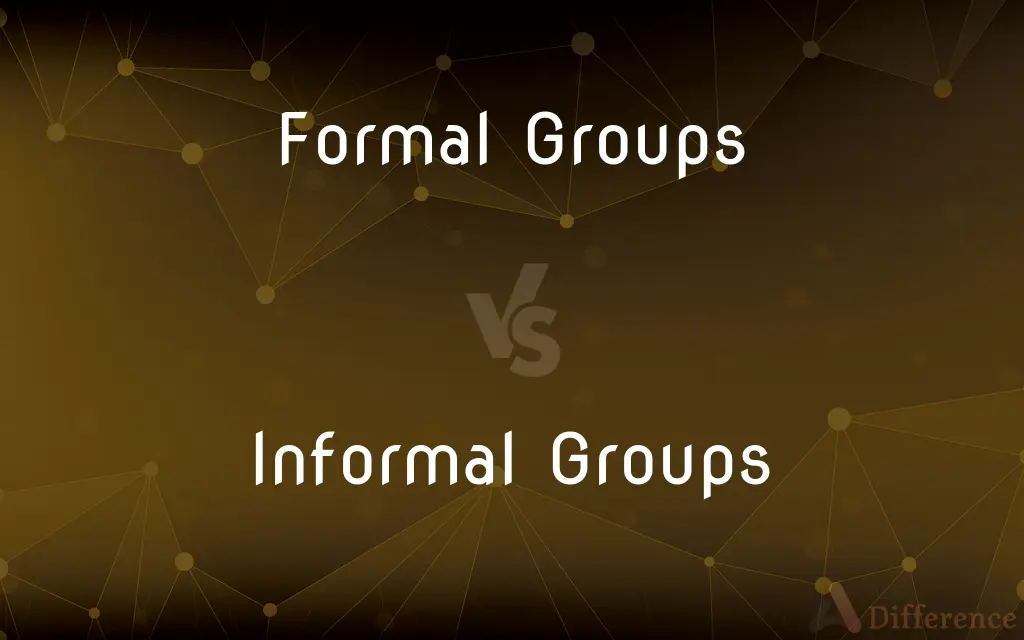Formal Groups vs. Informal Groups — What's the Difference?
By Tayyaba Rehman — Published on December 15, 2023
Formal Groups are organized with defined structures and roles; Informal Groups emerge spontaneously based on shared interests or affiliations.

Difference Between Formal Groups and Informal Groups
Table of Contents
ADVERTISEMENT
Key Differences
Formal Groups have a clear organizational structure with specific roles, responsibilities, and purposes, often recognized by official entities, while Informal Groups arise naturally without official recognition, based on friendships, shared interests, or other affiliations.
In many business settings, Formal Groups like committees, departments, or teams, are created to achieve specific objectives, whereas Informal Groups might emerge as coworkers bond over shared hobbies or experiences.
Formal Groups often have specific goals, timelines, and methods of operation, making them more predictable. On the other hand, Informal Groups are flexible, evolving organically without predetermined objectives.
The existence of Formal Groups is usually known widely, with membership, leadership, and objectives being transparent, while Informal Groups might be less visible, with members coming together casually without an outlined structure.
While Formal Groups can harness focused effort towards achieving set goals, Informal Groups play a vital role in building relationships, networking, and fostering a sense of belonging among members.
ADVERTISEMENT
Comparison Chart
Origin
Deliberately formed with specific purposes
Arise spontaneously based on shared interests or affiliations
Structure
Defined organizational structure
Lacks an official structure or hierarchy
Recognition
Officially recognized by organizations or entities
Typically not formally recognized
Purpose
Specific, goal-oriented
Varies; often social or based on shared interests
Flexibility
Less flexible due to defined roles and responsibilities
Highly flexible as they are not bound by official rules
Compare with Definitions
Formal Groups
Organized collections of individuals with specific objectives.
The company created several Formal Groups to oversee the new project.
Informal Groups
Non-structured gatherings not bound by official rules.
Informal Groups were essential for employees to share personal stories and relax.
Formal Groups
Teams or committees with a defined purpose and structure.
Training sessions were organized for members of the Formal Groups.
Informal Groups
Natural groupings based on friendships or commonalities.
The Informal Groups played a vital role in team bonding.
Formal Groups
Entities with clear organizational hierarchy and tasks.
The project's success was attributed to the efficiency of the Formal Groups.
Informal Groups
Unofficial assemblies arising from personal affiliations.
Informal Groups often met after work hours for social events.
Formal Groups
Groups set up deliberately to achieve organizational goals.
Regular meetings were held among the Formal Groups to ensure progress.
Informal Groups
Spontaneously formed groups based on shared interests.
The love for music led some employees to form Informal Groups during lunch breaks.
Formal Groups
Officially recognized assemblies with structured roles.
Within Formal Groups, each member knew their specific responsibilities.
Informal Groups
Collections of individuals without a set structure or objective.
Members of Informal Groups often shared valuable insights and ideas.
Common Curiosities
What's the key characteristic of Formal Groups?
Formal Groups have a clear organizational structure with specific roles and objectives.
Can individuals be a part of multiple Formal Groups?
Yes, individuals can be part of multiple Formal Groups based on their roles and responsibilities.
Are Formal Groups always large in size?
No, Formal Groups can range from small teams to large departments.
How do Informal Groups typically form?
Informal Groups arise spontaneously based on shared interests, friendships, or affiliations.
Can Informal Groups influence organizational decisions?
Yes, the collective voice of Informal Groups can influence decisions, especially if they represent a significant portion of the workforce.
How often do Informal Groups meet?
The frequency varies, as Informal Groups meet based on member availability and interests.
Do Informal Groups play a role in organizations?
Absolutely, Informal Groups often foster team bonding, networking, and a sense of community.
Can Formal Groups be temporary?
Yes, Formal Groups can be temporary, created for specific projects or timeframes.
Are Formal Groups bound by official rules?
Yes, Formal Groups often operate within established guidelines or protocols.
Can one belong to both Formal and Informal Groups simultaneously?
Absolutely, an individual can be part of both depending on their professional roles and personal affiliations.
How are leaders chosen in Informal Groups?
Leaders in Informal Groups often emerge naturally based on personality, experience, or group consensus.
Do Formal Groups always have a leader or manager?
Most Formal Groups have a designated leader or manager to guide and make decisions.
Can Informal Groups have specific goals?
While they form organically, Informal Groups can develop goals or objectives over time.
Is membership in Formal Groups typically fixed?
Membership in Formal Groups can be fixed or dynamic, depending on the group's purpose and structure.
How are disputes typically resolved in Informal Groups?
Informal Groups often resolve disputes through dialogue, consensus, or natural group dynamics.
Share Your Discovery

Previous Comparison
Prokaryotic Cells vs. Eukaryotic Cells
Next Comparison
Maybe vs. May beAuthor Spotlight
Written by
Tayyaba RehmanTayyaba Rehman is a distinguished writer, currently serving as a primary contributor to askdifference.com. As a researcher in semantics and etymology, Tayyaba's passion for the complexity of languages and their distinctions has found a perfect home on the platform. Tayyaba delves into the intricacies of language, distinguishing between commonly confused words and phrases, thereby providing clarity for readers worldwide.











































